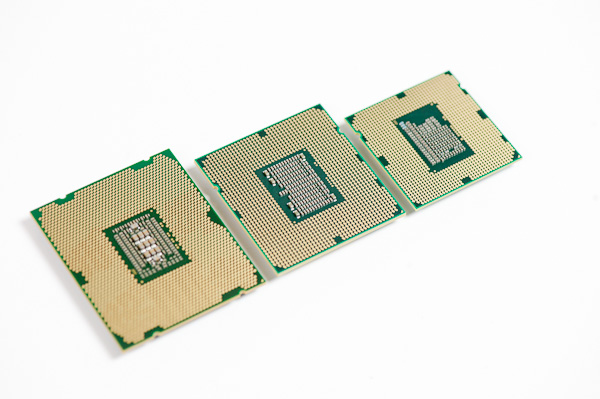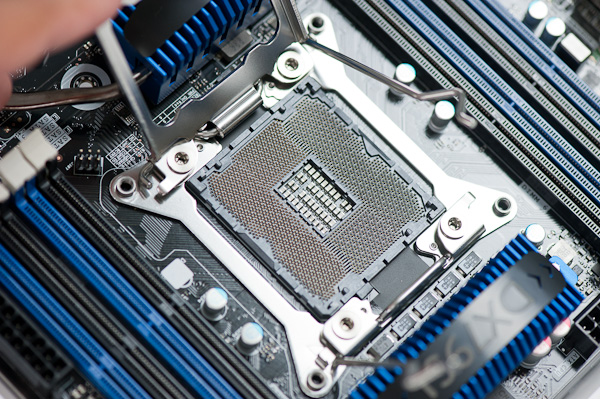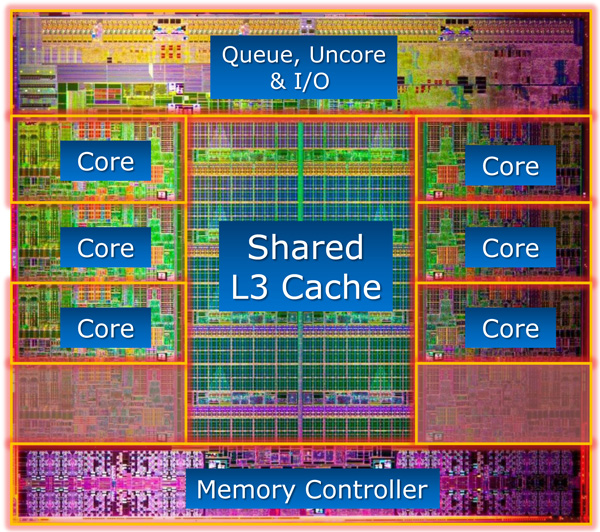Intel Core i7 3960X (Sandy Bridge E) Review: Keeping the High End Alive
by Anand Lal Shimpi on November 14, 2011 3:01 AM EST- Posted in
- CPUs
- Intel
- Core i7
- Sandy Bridge
- Sandy Bridge E
If you look carefully enough, you may notice that things are changing. It first became apparent shortly after the release of Nehalem. Intel bifurcated the performance desktop space by embracing a two-socket strategy, something we'd never seen from Intel and only once from AMD in the early Athlon 64 days (Socket-940 and Socket-754).
LGA-1366 came first, but by the time LGA-1156 arrived a year later it no longer made sense to recommend Intel's high-end Nehalem platform. Lynnfield was nearly as fast and the entire platform was more affordable.
When Sandy Bridge launched earlier this year, all we got was the mainstream desktop version. No one complained because it was fast enough, but we all knew an ultra high-end desktop part was in the works. A true successor to Nehalem's LGA-1366 platform for those who waited all this time.

Left to right: Sandy Bridge E, Gulftown, Sandy Bridge
After some delays, Sandy Bridge E is finally here. The platform is actually pretty simple to talk about. There's a new socket: LGA-2011, a new chipset Intel's X79 and of course the Sandy Bridge E CPU itself. We'll start at the CPU.
For the desktop, Sandy Bridge E is only available in 6-core configurations at launch. Early next year we'll see a quad-core version. I mention the desktop qualification because Sandy Bridge E is really a die harvested Sandy Bridge EP, Intel's next generation Xeon part:
If you look carefully at the die shot above, you'll notice that there are actually eight Sandy Bridge cores. The Xeon version will have all eight enabled, but the last two are fused off for SNB-E. The 32nm die is absolutely gigantic by desktop standards, measuring 20.8 mm x 20.9 mm (~435mm^2) Sandy Bridge E is bigger than most GPUs. It also has a ridiculous number of transistors: 2.27 billion.
Around a quarter of the die is dedicated just to the chip's massive L3 cache. Each cache slice has increased in size compared to Sandy Bridge. Instead of 2MB, Sandy Bridge E boasts 2.5MB cache slices. In its Xeon configuration that works out to 20MB of L3 cache, but for desktops it's only 15MB. That's just 1MB shy of how much system memory my old upgraded 386-SX/20 had.
| CPU Specification Comparison | ||||||||
| CPU | Manufacturing Process | Cores | Transistor Count | Die Size | ||||
| AMD Bulldozer 8C | 32nm | 8 | 1.2B* | 315mm2 | ||||
| AMD Thuban 6C | 45nm | 6 | 904M | 346mm2 | ||||
| AMD Deneb 4C | 45nm | 4 | 758M | 258mm2 | ||||
| Intel Gulftown 6C | 32nm | 6 | 1.17B | 240mm2 | ||||
| Intel Sandy Bridge E (6C) | 32nm | 6 | 2.27B | 435mm2 | ||||
| Intel Nehalem/Bloomfield 4C | 45nm | 4 | 731M | 263mm2 | ||||
| Intel Sandy Bridge 4C | 32nm | 4 | 995M | 216mm2 | ||||
| Intel Lynnfield 4C | 45nm | 4 | 774M | 296mm2 | ||||
| Intel Clarkdale 2C | 32nm | 2 | 384M | 81mm2 | ||||
| Intel Sandy Bridge 2C (GT1) | 32nm | 2 | 504M | 131mm2 | ||||
| Intel Sandy Bridge 2C (GT2) | 32nm | 2 | 624M | 149mm2 | ||||
Update: AMD originally told us Bulldozer was a 2B transistor chip. It has since told us that the 8C Bulldozer is actually 1.2B transistors. The die size is still accurate at 315mm2.
At the core level, Sandy Bridge E is no different than Sandy Bridge. It doesn't clock any higher, L1/L2 caches remain unchanged and per-core performance is identical to what Intel launched earlier this year.
The Lineup
| Processor | Core Clock | Cores / Threads | L3 Cache | Max Turbo | Max Overclock Multiplier | TDP | Price |
| Intel Core i7 3960X | 3.3GHz | 6 / 12 | 15MB | 3.9GHz | 57x | 130W | $990 |
| Intel Core i7 3930K | 3.2GHz | 6 / 12 | 12MB | 3.8GHz | 57x | 130W | $555 |
| Intel Core i7 3820 | 3.6GHz | 4 / 8 | 10MB | 3.9GHz | 43x | 130W | TBD |
| Intel Core i7 2700K | 3.5GHz | 4 / 8 | 8MB | 3.9GHz | 57x | 95W | $332 |
| Intel Core i7 2600K | 3.4GHz | 4 / 8 | 8MB | 3.8GHz | 57x | 95W | $317 |
| Intel Core i7 2600 | 3.4GHz | 4 / 8 | 8MB | 3.8GHz | 42x | 95W | $294 |
| Intel Core i5 2500K | 3.3GHz | 4 / 4 | 6MB | 3.7GHz | 57x | 95W | $216 |
| Intel Core i5 2500 | 3.3GHz | 4 / 4 | 6MB | 3.7GHz | 41x | 95W | $205 |
Those of you buying today only have two options: the Core i7-3960X and the Core i7-3930K. Both have six fully unlocked cores, but the 3960X gives you a 15MB L3 cache vs. 12MB with the 3930K. You pay handsomely for that extra 3MB of L3. The 3960X goes for $990 in 1K unit quantities, while the 3930K sells for $555.
The 3960X has the same 3.9GHz max turbo frequency as the Core i7 2700K, that's with 1 - 2 cores active. With 5 - 6 cores active the max turbo drops to a respectable 3.6GHz. Unlike the old days of many vs. few core CPUs, there are no tradeoffs for performance when you buy a SNB-E. Thanks to power gating and turbo, you get pretty much the fastest possible clock speeds regardless of workload.
Early next year we'll see a Core i7 3820, priced around $300, with only 4 cores and a 10MB L3. The 3820 will only be partially unlocked (max OC multiplier = 4 bins above max turbo).


















163 Comments
View All Comments
Hauk - Monday, November 14, 2011 - link
Was hoping to get 40 PCI-E lanes & 2600K performance for $300.. craptastic that they delay the 3820 till next year. Can't wait any longer, 2600K it is..medi01 - Monday, November 14, 2011 - link
Hi,why don't we see AMD cpu pricing along Intel CPU pricing?
g00ey - Monday, November 14, 2011 - link
I think it is false advertising to call the Bulldozer 8C an eight core CPU. It doesn't really have eight cores, it's actually only four cores where they have added an extra ALU inside each core. It's like doubling the core count of the i7s because of the hyperthreading (SMT) feature. The addition of ALUs is nothing but an enhanced version of hyperthreading so a Bulldozer 8C is only 4 cores, 6C is only 3 cores and 4C is only 2 cores.But AMD say; No No No, there are two computation CORES inside each MODULE.
What a BIG WAD of *BULLSHIT*!!!!!!!!!!!!!!!!!!!!!!!!!!!!
They should be thrown into jail for such fraudulent statements!!!
raddude9 - Monday, November 14, 2011 - link
Nope Mr. Troll.Bulldozer 8C can run 8 threads simultaneously. Sandy Bridge E with it's 6 multi-threaded cores can only run 6 threads at the same time, the other 6 threads have to wait.
BSMonitor - Monday, November 14, 2011 - link
Actually you are completely wrong.Hyperthreading actually allows 12 threads to fully utilize the resources of a 6 core processor.
Whereby, Bulldozer simply has double the Integer hardware. Allowing it to run 8 integer threads simulateously. So long as there are that many consecutive integer computations in a row on each thread. Beware when floating point threads start to appear. And then it crawls back to 4 cores.
raddude9 - Monday, November 14, 2011 - link
What did I say that is wrong?Hyperthreading means that each core holds the state of 2 threads. Only one thread can run at a time, usually when one thread stalls, the other thread can kick in. So, at best it can run 6 threads at once, the 6 hyperthreaded threads are waiting in the backround for their chance. But it still just runs 6 threads at once.
You are trying to mislead people with your mis-information on the Bulldozer Floating Point unit. It's FPU can run as either two independent 128bit FPUs or a single 256bit FPU. So it can run two independent Floating Point instructions at once. So, Regardless of whether Bulldozer is running Floating Point or Integer instructions, it can still run 8 threads at once.
LittleMic - Tuesday, November 15, 2011 - link
You are wrong because you are describing T1000 and T2000 CPU and not Intel with HT. Sun processor are indeed hiding memory access latency this way.Intel processors are actually scheduling micro instruction from both threads according to execution resources availabitity. It is quite old technology now so the white papers have disappeared from Intel web site, but if you have a look at
http://en.wikipedia.org/wiki/Hyper-threading
the picture on the right clearly shows that a pipeline stage can contain µ instructions coming from 2 threads
LittleMic - Tuesday, November 15, 2011 - link
No edit...Finally found "official" paper directly from Intel :
http://download.intel.com/technology/itj/2002/volu...
Have a look at page 10 that shows that all the pipeline contains instructions from both threads simultanously.
Lord 666 - Monday, November 14, 2011 - link
Anand,Have read mixed information on the release date for the 26xx series Xeons with respect to release date and architecture. Actually holding off a much needed server because have read either December or Jan.
With the socket the same, is the reviewed SB-E the same design as the new Xeons? Will there be 3D design like Ivy Bridge?
Thanks - Loyal reader for over 7 years
mwarner1 - Monday, November 14, 2011 - link
I am impressed by how much memory you had in your 386SX! My first (IBM compatible) PC was a 486DX2-50 I bought for my Software Engineering degree and it only had 4MB. This was pretty much standard for the time.